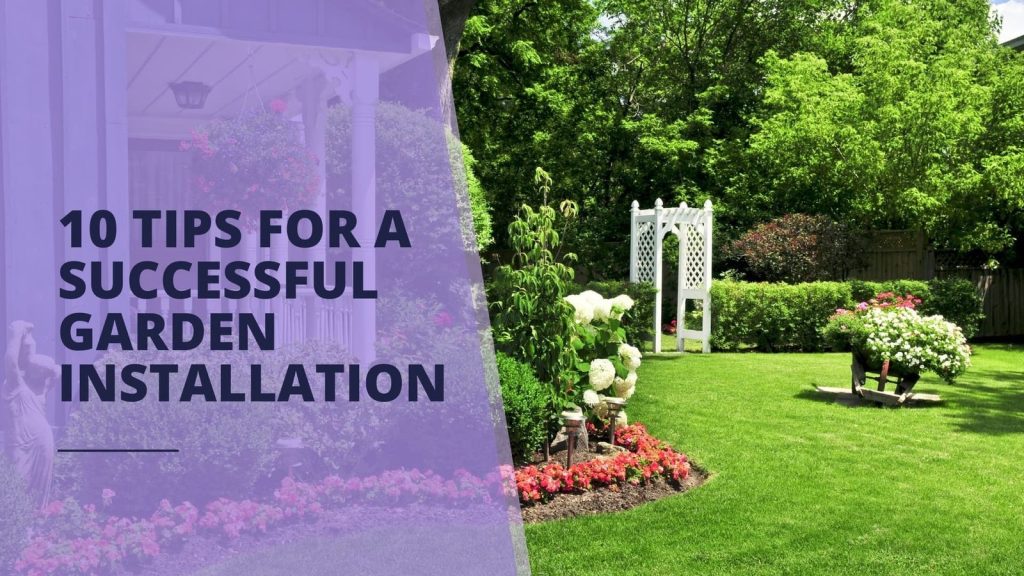Growing a lovely garden is not a one-day affair that starts with planting seeds and ends with flowers. It is very important to plan for a garden. For a small backyard garden or large-scale landscaping project, here are ten garden installation tips you can use to attain a productive garden.
The first step in the process of cultivating a garden is to have a definite garden design in mind.
However, for successful garden installation, the design plan should be as comprehensive as possible. First of all, one needs to take into account the size of the territory, the amount of direct sunlight it seems to receive, and how you envision using the garden.
So, how do you select an appropriate substrate for garden construction?
Garden soil
The basic principle that has to be complied with when developing an excellent garden is soil. The other factor is the type of soil that they choose since it determines the success of plants to grow. Extensive gardens prefer soils with a compressible subsoil layer of loamy type that has both sand and silt as well as clay materials. However, you may find that you require a change in your soil based on the region that you live in. Loam, on the other hand, is good because the soil is not so sandy that it does not hold water or is too clayey that it does not allow water to drain through. To decide the acidity/alkalinity of your soil and the nutrients available, you may have the soil analyzed. It can then be worked into the required consistency either with compost, organic material, or any other fertility-enhancing inputs.
Plant Selection
Second garden setup advice is the appropriate selection of plants. It is preferable to use native plants since they are well suited to the local climate and normally waterwise and low maintenance. In addition, consider the kind of light and moisture that are needed by the chosen plants for their proper growth and development. Each plant has its own requirement of the amount of sunlight it needs; it may be full sun or a shaded area.
Useful Information About Gardening for Giving Irrigation
Soil moisture control without overwatering can be easily done with irrigation systems such as drip irrigation or soaker hoses. These systems are useful, particularly in large gardens, since they assist in watering the plants at the root area only. If you must hand water the plants, then do so early in the morning or at night when there is little vaporization. Still, the gardens, which have been newly constructed, may require water more frequently, while the plants you have planted there may withstand less watering when they are fully grown.
Mulching
It should be noted that mulching is very important when it comes to planting and the establishment of gardens. Mulch is very useful in water retention, weed control, and moderating the soil temperature, provided that it is well applied. Other types of mulch include organic mulches such as straw, woodchuck, or compost, among others.
Fertilization
Another important aspect of garden maintenance is also fertilization. Your gardens require proper nutrition at the initial stages of putting up the gardens to ensure that plants have the nutrients they require for their growth. Apply an organic fertilizer or go for natural ones, such as manure and compost, during the growing period of the plants. Do not apply higher amounts of fertilizer since it has been known to lead to problems of an imbalance of nutrients causing stress to the plants.
Pay Attention to Sunlight
Average plants require sunlight of at least six hours a day, with some requiring partial or even full shade. Do not allow the sun patterns in your garden to defeat you; instead, use the patterns as a guide when planting. Plant flowers that require direct sunlight, such as marigolds and zinnias, in areas that receive plenty of sun while planting shade-tolerant flowers, such as hostas, under trees or in areas that receive little direct sunlight.
Add organic matter regularly.
Annually applying compost or well-rotten manure can go a long way in replenishing nutrients within the soil. Organic matter enhances the physical properties of the soil; it increases the soil’s water-holding capacity and stimulates microbial action—all of which are very important for a healthy garden.
Distancing
Equate aseptic distances between plants and void overcrowding because it restricts air circulation.
When starting a new garden, it is always a good idea to plant as many plants as possible, but it is always counterproductive since overcrowding leads to areas such as inadequate aeration and competition for nutrients. The spacing of plants should be in accordance with the size of each plant in order to accommodate growth and development. Adequate space, on the other hand, is not only desirable for the growth of the plants but also for the easy management of the yard.
Raised beds are to be employed so as to gain better control.
If the native soil is bad or if one wants more control over the layout of the garden, then raised beds should be used. This type of garden bed provides better drainage, avoids compacting of the soil in the garden bed, and you are able to fill the garden bed with the right type of soil that will complement the type of plants you will be growing. They also require little attention when it comes to the control of pests and weeds.
Plan for Long-Term Maintenance
It is crucial for your garden that after installation further care should be taken so that it remains productive in the longer run. Trimming of the plants is recommended from time to time in order to remove any unwanted vegetation from the plants or to remove overgrown branches and wilting flowers of the plants. Also, you have to water your plants and feed them according to different seasons in order to cater to their needs.
These were some golden garden-landscaping tips!



